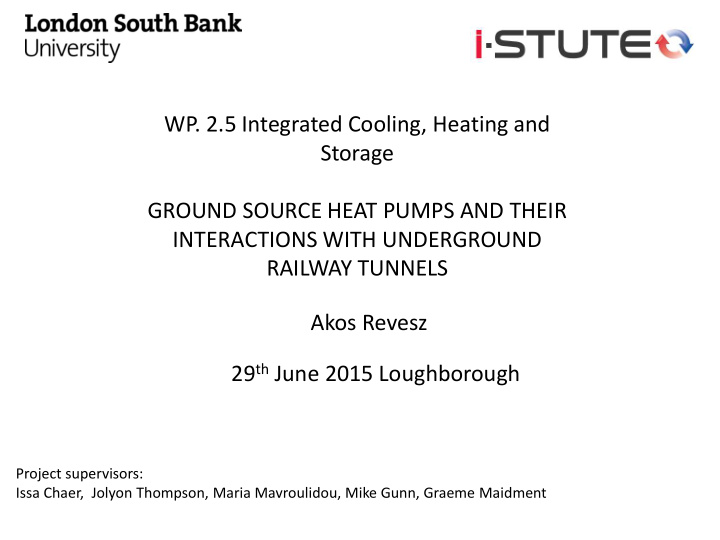



WP. 2.5 Integrated Cooling, Heating and Storage GROUND SOURCE HEAT PUMPS AND THEIR INTERACTIONS WITH UNDERGROUND RAILWAY TUNNELS Akos Revesz 29 th June 2015 Loughborough Project supervisors: Issa Chaer, Jolyon Thompson, Maria Mavroulidou, Mike Gunn, Graeme Maidment
1. Intro Background • To investigate the interactions of underground railway (UR) tunnels and borehole heat exchangers (BHE) • To investigate the potential indirect use of waste heat from the tunnels to heat buildings above ground Deliverables • Development of a model • Case study materials
2. Research Plan Today Up to Date Activities: • Familiarization with the selected simulation software Activities: • Development of modelling strategy • Site familiarization • Preliminary 2D model development • Literature review • Further development of the 2D • Evaluation of simulation software model Delivered: Delivered: • Conference paper for the ICR 2015 • The literature review report Planned Activities: • Summary report on 2D model • 3D model development
3. Preliminary model A time dependent FE model. 3.1. Modelling objectives: • Thermal effects of UR and a BHE on undisturbed ground temperatures • Thermal interactions of the two systems based on a certain set of conditions 3.2. Generic Features: • Two dimensional • Simulation period of 6 years • Geometrical parameters, material properties, initial, boundary and working conditions implemented within the model were based on typical conditions for London • Groundwater movement has not been considered within the preliminary model
3.3. Initial and Boundary conditions: Time periodic temperature boundary on the surface The lateral and the Soil bottom boundaries of Time periodic temperature boundary the domain was assumed to be adiabatic Tunnel BHE Time periodic heat flux condition
2.4. Validations: Temperate boundary on the soil surface - validated against Brandl’s, (2006) analytical solution. Temperate distribution by depth
The model predictions of the tunnel wall temperatures: The simulated values were considered to be appropriate due to matching conditions reported by Thompson et al ., (2008) and Gilbey et al . (2011). Performance of the BHE heat flux: Comparison to data obtained from thermocouples (LSBU). Only a few degrees Celsius of disparity between the two sets of data. The modelling assumption was maintained.
2.4. Analyses and results: The effect of heat loads on initial ground temperature at a specific point was investigated through three different setups as follows: • Option (a) only BHE heat load • Option (b) only tunnel heat load • Option (c) both heat loads The key conclusion drawn from this study is that an UR tunnel has more significant effect on the surrounding soil temperature than a BHE.
The second investigation aimed to study the interactions of the BHE and the tunnel by examining the temperatures at a point on the wall of the BHE in response to the closer proximity of the tunnel. 0 m Soil Tunnel BHE 50 m Point of interest -100 m 0 m 150 m The preliminary results clearly demonstrate that: • Interactions occur between URs and neighbouring GSHP installations. • In heating mode, this could be beneficial to the efficiency of a GSHP. • Likely to be disadvantageous for GSHPs operating in cooling mode.
The second investigation aimed to study the interactions of the BHE and the tunnel by examining the temperatures at a point on the wall of the BHE in response to the closer proximity of the tunnel. 0 m Soil BHE 3 m Tunnel Point of interest -100 m 0 m 150 m The preliminary results clearly demonstrate that: • Interactions occur between URs and neighbouring GSHP installations. • In heating mode, this could be beneficial to the efficiency of a GSHP. • Likely to be disadvantageous for GSHPs operating in cooling mode.
2.5. Additional work within the 2D model: Objectives Status • Incorporate sub-surface flow into the model (coupled heat and mass flow). • Investigate scenarios where tunnels are running through sands rather then clay. • Investigate the effects of parallel running tunnels on their surroundings. • Application of periodic heat flux condition on the tunnel wall surface. • Investigate the effect of flux from the Earth on the tunnel and its surroundings. • Incorporate tunnel wall and its material properties into to the model. Investigate its effect on temperature distribution. • Summarise 2D modelling results. Draft a report. Ongoing
3 . Next steps… 3D model developments and validations
Questions
Recommend
More recommend